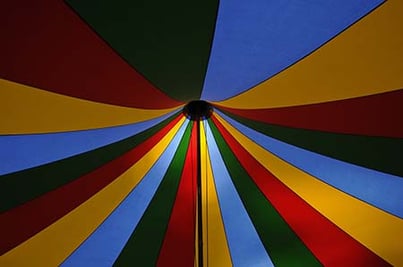
Opaque materials, also known as blackout fabrics, do not allow light to pass through or penetrate them. For textiles, the measurement of opacity in the fabric refers to the percentage of light it blocks out. Think about entirely opaque materials like blackout fabrics -- these provide complete coverage from light. You might see these specialty fabrics used in wedding or party tents. But did you know that materials come in varying levels of opacity?
A Little Background
Blackout fabric has been around since the early 1900s, coming from some technological advancements, including top coatings, layering, and uses of different textiles. Specifically, blackout fabric is a specialty textile with opaque material layered between at least two exterior fabrics. Those external layers act like thick shields, protecting each other, with the opaque cloth in the middle acting as a barrier to light. But like many significant breakthroughs, the potential uses were just being considered.
How Blackout Fabrics Work
The level of opacity can be manipulated in fabrics. This means you can use textiles that are either entirely or somewhat opaque. You should have light completely blocked or even allow a certain amount of opacity to let some light pass through. Depending on the particular usage, you will want to evaluate the product's use situation and even test if any factors can affect the ambient light, including position, seasonality, time of day, or surrounding structures.
Remember that blackout fabrics are often a little thicker given their construction; this can provide added benefits, including acoustic dampening and thermal protection.
What are the different types of blackout fabrics?
- Light Blocking: Blackout fabrics are engineered to effectively block out light, providing a high level of darkness when fully closed. They have a dense construction that prevents sunlight from passing through, effectively blocking most incoming light. Blackout fabrics can significantly reduce glare, create privacy, and improve sleep quality by creating a darkened environment.
- Thermal Insulation: In addition to light control, blackout fabrics often offer thermal insulation properties. They have a layered or coated construction that helps to reduce heat transfer, preventing hot or cold air from entering or escaping through windows. This can contribute to energy efficiency by reducing the need for heating or cooling.
- Multiple Layers: Blackout fabrics often have multiple layers to enhance light blocking and insulation properties. These layers may include a face fabric, a foam or acrylic backing, and sometimes an additional lining or interlining. Combining these layers creates a dense and opaque material that effectively blocks light.
- Light Absorption: Blackout fabrics are designed to absorb light rather than allow it to pass through. They are usually made of tightly woven or knit materials with high light absorption capabilities. This helps to minimize light reflection and penetration, creating a darker and more secluded environment.
- Sound Absorption: Some blackout fabrics also possess good absorption properties, helping to reduce noise levels within a space. The dense construction of the material can help absorb and dampen sound waves, providing a quieter atmosphere.
- Versatility: Blackout fabrics come in various colors, patterns, and textures, offering multiple design options to suit different decor styles. They are in various materials, including polyester, cotton, blends, and specialty fabrics.
So, what are some of the uses of opaque fabrics?
- Awnings & Patio Covers: Using a semi-opaque fabric in a shade structure allows just enough light to filter through - providing customers shade from direct sunlight but still enough translucence to enjoy the brightness. For complete shade, you can use blackout fabrics.
- Curtains & Drapes: Using semi-opaque or 100% blackout fabrics for curtains for industrial or home use adds to the ambiance of your environment and helps reduce solar heat gain. Think of reduced air conditioning costs. Remember, you can also use a semi-opaque fabric for your curtains or drapes to allow a little bit of light through.
- Tents: Blackout fabrics are beneficial when using tents for weddings or parties. These keep out the heat, sunlight, and UV rays, allowing guests to feel completely comfortable. Read more about blackout tent fabric considerations here.
- Boat Covers: Boat covers can also be made with blackout fabric. Selecting an entirely opaque covering will protect your boat’s finish/paint from direct sunlight damage while in storage or sitting on the dock.
- Agriculture Curtains: Depending on the usage and requirements, agriculture curtain fabrics can be translucent or highly opaque to let light in or to control temperatures better.
Are you looking for the perfect tent fabric material? Download our free "Five Factors to Consider When Buying Tent Fabric Material" Guide.
